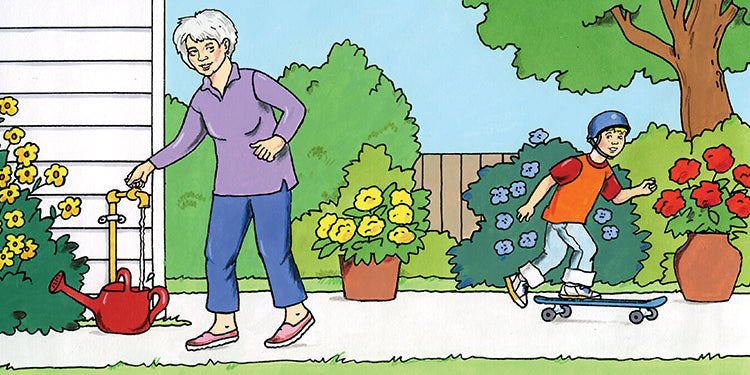
This is a guest blog post by Dr. Geraldine Haggard, who is a retired teacher, Reading Recovery teacher leader, author, and university teacher. It is the second in a series about utilizing book introductions to help guided reading groups develop their reading strategies. To read the first post, click here .
The first blog in this series included reasons to use book introductions in a guided reading group setting. I also included hints for selection of a “just right book” and tips on teacher preparation for the introduction. Today's blog shares examples of effective book introductions for two differently-leveled Hameray titles: Buddy Boy and His Skateboard and Dragon's Friend.
BOOK ONE: BUDDY BOY AND HIS SKATEBOARD
Series: Kaleidoscope Collection . Guided reading level: E. Genre: Narrative.
PREPARATION:
Imagine that your guided reading groups includes children who were not reading with fluency. As you read Buddy Boy and His Skateboard , you feel that the quotations in the book could be used to help children read more fluently and recognize the use of the quotation marks.
There are three compound words in the story: 'someone,' 'skateboard,' and 'grandma.' You predict that the children can use the pictures and meaning cues to determine the two latter words, but you decide to introduce the word 'someone' in your introduction.
BOOK INTRODUCTION:
- Distribute the books. Ask the children to study the cover and meet Buddy Boy. Where is he? How do you think he feels about the skateboard? As we read the story we will discover how he enjoys the skateboard, and how something sad almost happens to him.
- Ask the children to look through the pictures and decide who the other characters in the book are.
- Use page 3 to introduce the quotation marks. Model what Mom said with expression and ask the children to read the two lines of conversation with you. Remind them to read all the quotations in the story in that way. You might emphasize the word 'Please.’
- Now we are ready to read and find out what happens to Buddy Boy and his skateboard.
- Watch and listen as the children do the first reading of the book. Did they read with fluency?
FOLLOW-UP ACTIVITIES
Follow up the reading with these discussion questions:
- Why does Buddy Boy have the skateboard in bed with him?
- What lesson do you think Buddy Boy learned?
- Why do you think his dad threatened to take his skateboard?
BOOK TWO: DRAGON'S FRIEND
Series: Joy Cowley Early Birds . Guided Reading Level: G. Genre: Narrative.
PREPARATION:
Three notable punctuation marks appear in the book. The apostrophes make the word a possessive. The quotation and exclamation marks can help students read with greater fluency and expression and understand the characters’ emotions.
Multiple-meaning words also appear in the book. Page 2 introduces the word 'poor.’ Page 10 introduces the word 'scales.' The picture on the two pages can help the children understand the meanings of these words. The word 'cared' on page 14 is important to help the students understand why the dragon decides he has friends.
INTRODUCTION:
- Distribute the books. Ask the children to study the front cover. Read the title with the children . Why do you think the dragon is crying? How many dragons are in the picture? Why does the word “Dragon's” contain an apostrophe? Explain its meaning.
- Use the title page to meet the other characters in the story. Where might they be? Why are they looking down? What do you think they may find?
- Ask the children to read the first line on page 2. Encourage them to use the picture and discuss the idea of the dragon being 'poor.' Go to page 14 and use the double picture to discover the meaning of the word 'cared.' The readers need to understand why the children helped the dragon.
- Ask the children to find some quotation marks and review why they are there. Do the same thing with an exclamation mark.
- Invite the children to read and discover how the dragon's problem was solved.
FOLLOW-UP ACTIVITIES:
In addition to the follow-up activities below, the back cover of Dragon’s Friend has some excellent After Reading suggestions.
- Do you think Joy Cowley gave the book a good title? Can you find another possible title on page 16? This will require the use of the understanding of the apostrophe.
- Invite each child to write about a time that someone cared for him/her and helped solve a problem. Remind them that some of the words and spellings they need to use can be found in the book. The writings could be illustrated and compiled into a book for the classroom library.
Next week, I will conclude this blog series by examining one last book and offering tips for teacher reflection after the guided reading group meeting.
~~~
Geraldine Haggard is the author of several books from our Kaleidoscope Collection . She spent 37 years in the Plano, TX school system. She currently tutors, chairs a committee that gifts books to low-income students, teaches in her church, and serves as a facilitator in a program for grieving children.
~~~
Click the left image below to download an information sheet with key features about the Kaleidoscope Collection , which contains Buddy Boy and His Skateboard and books written by Geraldine Haggard. Click the rigth image below to download an information sheet about Joy Cowley Early Birds , which contains Dragon's Friend.























































![6 Fun and Easy Activities to Practice Sequencing [Grades K-1]](http://www.hameraypublishing.com/cdn/shop/articles/Red_Typographic_Announcement_Twitter_Post-5_bf1ae163-a998-4503-aa03-555b038d1b76_600x.png?v=1689961568)